Live (Undeployed) Inflator Module
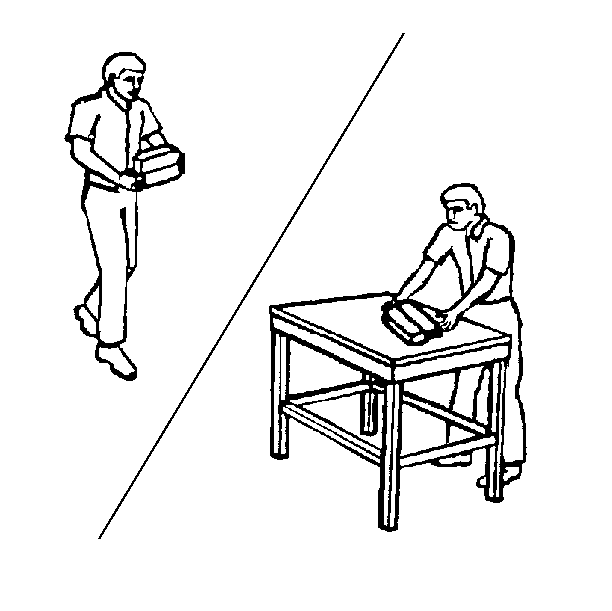
Caution: When you are carrying an undeployed inflator module:
• Do not carry the inflator module by the wires or connector on
the inflator module • Make sure the bag opening points away from you
Use special care when handling and storing a live (undeployed) inflator module. An air bag deployment produces rapid gas generation. This may cause the inflator module, or an object in front of the inflator module, to jettison through the air in the unlikely event of an accidental deployment.
Shipping Procedures for Live (Undeployed) Inflator Modules
Service personnel should refer to the latest Service Bulletins for proper SIR inflator module shipping procedures.
Scrapping Procedure
During the course of a vehicle's useful life, you may need to dispose of a live (undeployed) inflator module. The following information covers the proper procedures for disposing of a live inflator module. Before you dispose of a live inflator module, you must deploy the inflator module. Do not dispose of live inflator modules through normal refuse channels.
Caution: In order to prevent accidental deployment of the air bag which could cause personal injury, do not dispose of an undeployed inflator module as normal shop waste. The undeployed inflator module contains substances that could cause severe illness or personal injury if the sealed container is damaged during disposal. Use the following deployment procedures to safely dispose of an undeployed inflator module. Failure to dispose of an inflator module as instructed may be a violation of federal, state, province, or local laws.
Do not deploy an air bag in the following situations:
| • | If you replace an inflator module under warranty, you may need to return the inflator module, undeployed, to Delphi Interior & Lighting Systems. Refer to the latest service bulletin regarding SIR shipping procedures. |
| • | If a vehicle is the subject of a Product Liability Report related to the SIR system and is subject to a Preliminary Investigation (GM-1241), do not alter the SIR system in any manner. Refer to the latest service bulletin on SIR shipping procedures. |
| • | If a vehicle is involved in a campaign affecting the inflator modules, follow the instructions in the Campaign Service Bulletin for proper SIR handling and shipping procedures. |
Deployment Procedures
The inflator module may be deployed inside or outside of the vehicle. The method used depends upon the final disposition of the vehicle. Review the following procedures in order to determine which procedure will work best in a given situation.
Deployment Outside of the Vehicle (Inflatable Restraint Steering Wheel Module)
Tools Required
J 38826 SIR Deployment Harness
When you intend to return the vehicle to service, deploy the inflator modules outside of the vehicle. Consider the following examples:
| • | Using the SIR Diagnostics, you determine that the inflator module does not function correctly. |
| • | The inflator module is cosmetically damaged, such as a scratch or a rip in the cover. |
| • | The inflator module pigtail (if equipped) is damaged. |
| • | The inflator module connector is damaged. |
| • | An inflator module connector terminal is damaged. |
Deployment and disposal of a malfunctioning inflator module is subject to any required retention period.
You must follow these inflator module deployment procedures exactly. Always wear safety glasses during this deployment procedure. Do not remove your safety glasses until the deployed inflator module is scrapped or shipped. Before performing theses deployment procedures, ensure that you are familiar with servicing the SIR system. You should also know how to handle the inflator module properly. Carefully read the procedures before you begin. These procedures require the use of the following tools:
| • | J 38826 SIR Deployment Harness |
| • | The appropriate pigtail adapter |
Do not perform the procedure without the J 38826 and the adapter.
CAUTION: When you are deploying an inflator module for disposal, perform the deployment procedures in the order listed. Failure to follow the procedures in the order listed may result in personal injury.
- Turn the ignition switch to the LOCK position.
- Remove the key.
- Put on safety glasses.
- Inspect the J 38826 and the appropriate pigtail adapter for damage. If either the harness or the adapter is damaged, obtain a replacement.
- Short the 2 SIR deployment harness leads together by fully seating one banana plug into the other, as shown in the figure.
- Connect the appropriate pigtail adapter (2) to the J 38826 .
- Remove the inflatable restraint steering wheel module from the vehicle. Refer to Supplemental Inflatable Restraint (SIR) Steering Wheel and Column in Steering.
- Remove the horn lead from the back of the inflatable restraint steering wheel module, if applicable.
- Remove the redundant steering wheel control lead(s) from the back of the inflatable restraint steering wheel module, if applicable.
- Remove all horn buttons and steering wheel control buttons from the inflatable restraint steering wheel module, if applicable.
- With the vinyl trim cover facing up and away from the surface, place the inflatable restraint steering wheel module on a work bench or other surface.
- Place the inflatable restraint steering wheel module away from all loose or flammable objects.
- Clear a space on the ground about 1.85 m (6 ft) in diameter where you intend to deploy the inflatable restraint steering wheel module. If possible, use a paved, outdoor location free of activity. Otherwise, use a space free of activity on the shop floor. Provide sufficient ventilation.
- Clear all loose or flammable objects from the deployment area.
- Place the inflatable restraint steering wheel module in the space just cleared, with its vinyl trim cover facing up.
- Extend the SIR deployment harness and the pigtail adapter to full length from the inflatable restraint steering wheel module.
- Place a power source near the shorted end of the SIR deployment harness. Use a vehicle battery when available, but always use a power source that meets the following criteria:
- Connect the inflatable restraint steering wheel module (1) to the pigtail adapter (2) on the SIR deployment harness (3).
- Clear the area of all people and loose or flammable objects.
- Place the inflatable restraint steering wheel module with the vinyl trim cover facing up.
- Notify all people in the immediate area before you deploy the inflatable restraint steering wheel module for the following reasons:
- Separate the 2 banana plugs on the SIR deployment harness.
- Connect the SIR deployment harness wires to the power source. This immediately deploys the inflatable restraint steering wheel module.
- Use a vehicle battery when available, but always use a power source that complies to the following criteria:
- Disconnect the SIR deployment harness from the power source.
- Short the SIR deployment harness leads together by fully seating 1 banana plug into the other.
- In the unlikely event that the inflatable restraint steering wheel module did not deploy after following these procedures, proceed immediately with Steps 33-36. If the inflatable restraint steering wheel module did deploy, proceed with Steps 28-32.
- Put on a pair of shop gloves in order to protect your hands from possible heat and irritation when you handle the deployed inflatable restraint steering wheel module.
- The metal canister and the area surrounding the inflatable restraint steering wheel module are very hot. Do not touch the metal areas of the inflatable restraint steering wheel module for about 10 minutes after deployment. Use care if you must move the deployed inflatable restraint steering wheel module. Always wear gloves and handle the inflatable restraint steering wheel module by the air bag or by the vinyl trim.
- Disconnect the pigtail adapter from the inflatable restraint steering wheel module as soon after the deployment as possible. This will prevent the hot inflatable restraint steering wheel module canister from damaging either the pigtail adapter or the SIR deployment harness. The pigtail adapter and the SIR deployment harness are reusable.
- Inspect both the pigtail adapter and the SIR deployment harness for damage after each use. Replace the pigtail adapter or the SIR deployment harness, as necessary.
- Allow the deployed inflatable restraint steering wheel module to cool for at least 10 minutes. Dispose of the deployed inflatable restraint steering wheel module through the normal refuse channels.
- Wash your hands with a mild soap and water.
- Disconnect the SIR deployment harness from the power source. Confirm that you have shorted the 2 banana plugs together.
- Disconnect the pigtail adapter from the inflatable restraint steering wheel module.
- Temporarily store the inflatable restraint steering wheel module with the vinyl trim cover facing up.
- Call the Technical Assistance group for further assistance.
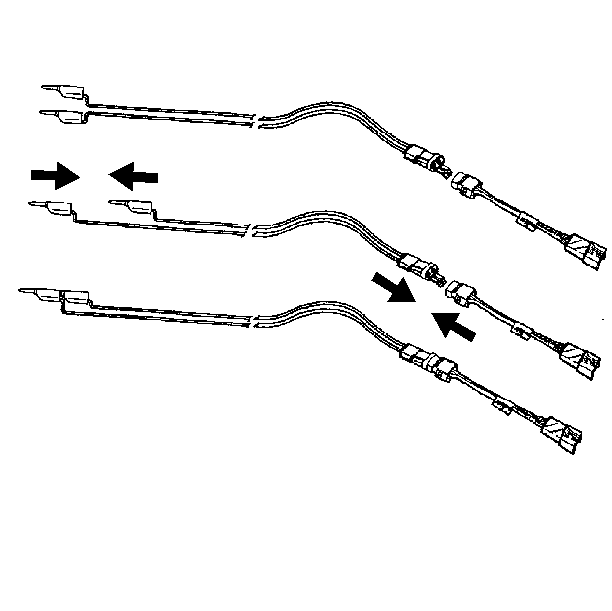
Important: This information applies only to inflatable restraint steering wheel modules. Refer to Deployment Outside of the Vehicle (Inflatable Restraint IP Module) in this section for information on inflatable restraint IP module scrapping.
| • | Keep the SIR deployment harness (1) shorted until you are ready to deploy the air bag. |
| • | Do not connect the SIR deployment harness to a power source until you are ready to deploy the air bag. |
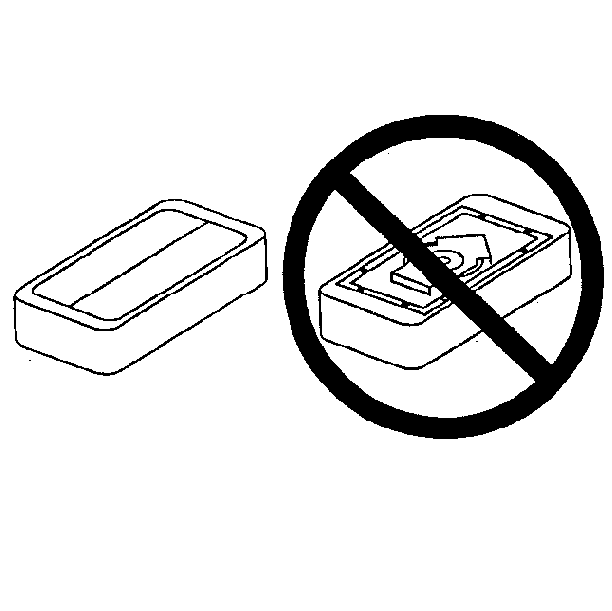
Caution: When you are carrying an undeployed inflator module:
• Do not carry the inflator module by the wires or connector on
the inflator module • Make sure the bag opening points away from you


| • | 12 volts minimum |
| • | 2 A minimum |

Important: Firmly seat the pigtail adapter into the inflatable restraint steering wheel module connector. If you do not do this, the inflator module may not deploy.
| • | The deployment harness shall remain shorted until you are ready to deploy the air bag. |
| • | Do not connect the SIR deployment harness to a power source until you are ready to deploy the air bag. |
| • | The inflator module will immediately deploy when you connect the power source. |
| • | An inflatable restraint steering wheel module deployment is very loud. |
| • | The deployment may startle any uninformed people in the area. |
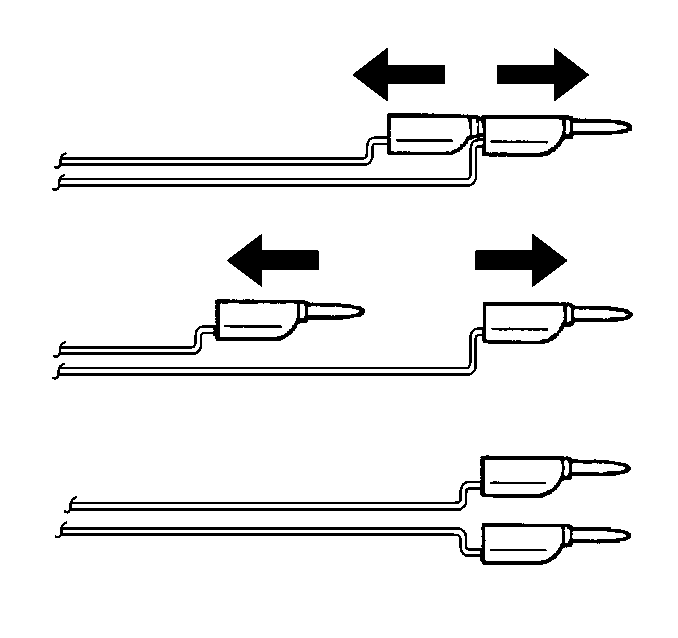
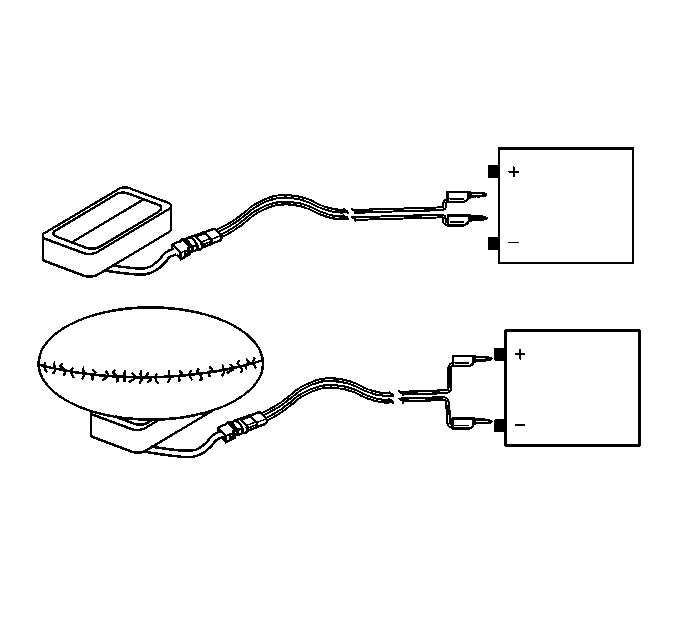
CAUTION: When you are deploying an inflator module for disposal, perform the deployment procedures in the order listed. Failure to follow the procedures in the order listed may result in personal injury.
Notice: When the air bag deploys, the inflatable restraint steering wheel module may jump about 30 cm (1 ft) vertically. This is a normal reaction of the inflatable restraint steering wheel module to the force of the rapid gas expansion inside the air bag.
Notice: The rapid gas expansion involved with deploying an air bag is very loud. Notify all people in the immediate area that you intend to deploy the inflator module.
| • | 12 volts minimum |
| • | 2 A minimum |

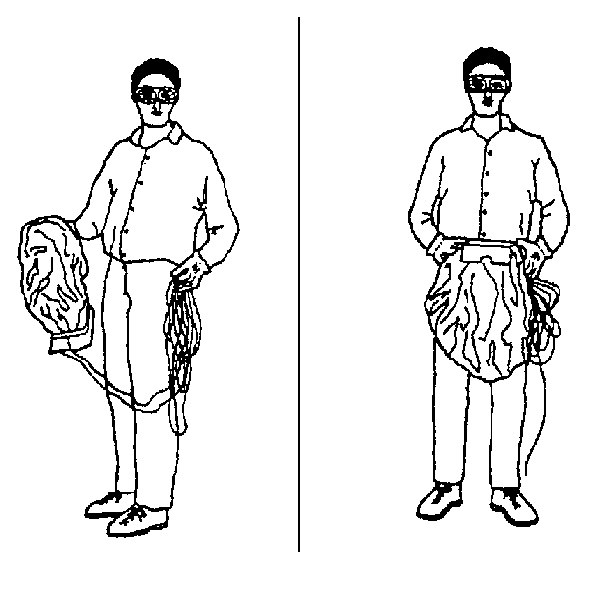
After the inflatable restraint steering wheel module has deployed, the surface of the air bag may contain a powdery residue. This powder consists primarily of cornstarch (used to lubricate the bag as it inflates), and by-products of the chemical reaction. The deployment reaction produces sodium hydroxide dust (similar to lye soap). The sodium hydroxide quickly reacts with the atmospheric moisture. This atmospheric moisture converts the sodium hydroxide into sodium carbonate and sodium bicarbonate (baking soda). Therefore, you will probably find no sodium hydroxide present after the deployment. Gloves and safety glasses are recommended. Gloves and safety glasses prevent possible irritation of the skin or eyes.
CAUTION: Immediately following the deployment of an air bag, the metal surfaces of the inflator module are very hot. Do not place the deployed inflator module near any flammable objects. Wait for about ten minutes before touching any metal surface of the inflator module. Disregarding these precautions may cause fire or personal injury.

Notice: Follow the remaining steps in the unlikely event that the inflatable restraint steering wheel module did not deploy after following these procedures.
Caution: When you are carrying an undeployed inflator module:
• Do not carry the inflator module by the wires or connector on
the inflator module • Make sure the bag opening points away from you
Deployment Outside of the Vehicle (Inflatable Restraint IP Module)
Caution: In order to prevent accidental deployment of the air bag which could cause personal injury, do not dispose of an undeployed inflator module as normal shop waste. The undeployed inflator module contains substances that could cause severe illness or personal injury if the sealed container is damaged during disposal. Use the following deployment procedures to safely dispose of an undeployed inflator module. Failure to dispose of an inflator module as instructed may be a violation of federal, state, province, or local laws.
General Motors dealers should refer to the latest General Motors Service Bulletins for live (undeployed) inflatable restraint IP module scrapping and disposal procedures. All others should contact a local General Motors dealership for live inflatable restraint IP module scrapping and disposal procedures. Dispose of deployed inflatable restraint IP modules through normal refuse channels.
Deployment Inside Vehicle (Vehicle Scrapping Procedure)
Deploy the inflator modules inside of the vehicle when destroying the vehicle or when salvaging the vehicle for parts. This includes but is not limited to the following situations:
| • | The vehicle has completed its useful life. |
| • | Irreparable damage occurs to the vehicle in a non-deployment type accident. |
| • | Irreparable damage occurs to the vehicle during a theft. |
| • | The vehicle is being salvaged for parts to be used on a vehicle with a different VIN as opposed to rebuilding as the same VIN. |
CAUTION: When you are deploying an inflator module for disposal, perform the deployment procedures in the order listed. Failure to follow the procedures in the order listed may result in personal injury.
- Turn the ignition switch to the OFF position.
- Remove the ignition key.
- Put on safety glasses.
- Remove all loose objects from the front seats.
- Disconnect the inflatable restraint steering wheel module yellow 2-way connector.
- Cut the yellow 2-way harness connector out of the vehicle, leaving at least 16 cm (6 in) of wire at the connector.
- Strip 13 mm (0.5 in) of insulation from each of the connector wire leads.
- Cut 2 4.6 M (15 ft) deployment wires from a 0.8 mm² (18 gage) or thicker multi-strand wire. Use these wires in order to fabricate the driver deployment harness.
- Strip 13 mm (0.5 in) of insulation from both ends of the wires cut in the previous step.
- Twist together 1 end from each of the wires in order to short the wires. Deployment wires shall remain shorted, and not connected to a power source until you are ready to deploy the air bag.
- Twist together 1 connector wire lead to one deployment wire.
- Verify that the previous connection is secure.
- Bend flat the twisted connection.
- Secure and insulate the connection using electrical tape.
- Twist together, bend, and tape the remaining connector wire lead to the remaining deployment wire.
- Connect the deployment harness to the inflatable restraint steering wheel module yellow 2-way connector.
- Route the deployment harness out of the vehicle's driver side.
- Disconnect the inflatable restraint IP module yellow 2-way harness connector.
- Cut the harness connector out of the vehicle, leaving at least 16 cm (6 in) of wire at the connector.
- Strip 13 mm (0.5 in) of insulation from each of the connector wire leads.
- Cut 2 6.1 M (20 ft) deployment wires from a 0.8 mm² (18 gage) or thicker multi-strand wire. These wires will be used to fabricate the passenger deployment harness.
- Strip 13 mm (0.5 in) of insulation from both ends of the wires cut in the previous step.
- Twist together 1 end from each of the wires in order to short the wires.
- Twist together 1 connector wire lead to 1 deployment wire.
- Bend flat the twisted connection.
- Secure and insulate the connection using electrical tape.
- Twist together, bend, and tape the remaining connector wire lead to the remaining deployment wire.
- Connect the deployment harness to the inflatable restraint IP module yellow 2-way connector.
- Route the deployment harness out of the passenger side of the vehicle.
- Clear the inside and outside of the vehicle of any people or loose and flammable objects.
- Stretch the driver harness to full length.
- Stretch the passenger harness to full length.
- Completely cover the windshield and front door window openings with a drop cloth.
- Place a power source, 12V minimum/2A minimum (vehicle battery) near the shorted end of the harness.
- Separate the 2 ends of the driver deployment harness wires.
- Connect the driver deployment harness wires to the power source in order to deploy the inflatable restraint steering wheel module.
- Disconnect the driver deployment harness wires from the power source.
- Separate the 2 ends of the passenger deployment harness wires.
- Connect the passenger deployment harness wires to the power source in order to deploy the inflatable restraint IP module.
- Disconnect the passenger deployment harness wires from the power source.
- Twist together 1 end of each wire on the driver deployment harness in order to short the wires.
- Twist together 1 end of each wire on the passenger deployment harness in order to short the wires.
- Remove the drop cloth from the vehicle.
- Disconnect both harnesses from the vehicle.
- Discard the harnesses.
- Scrap the vehicle in the same manner as a non-SIR equipped vehicle.
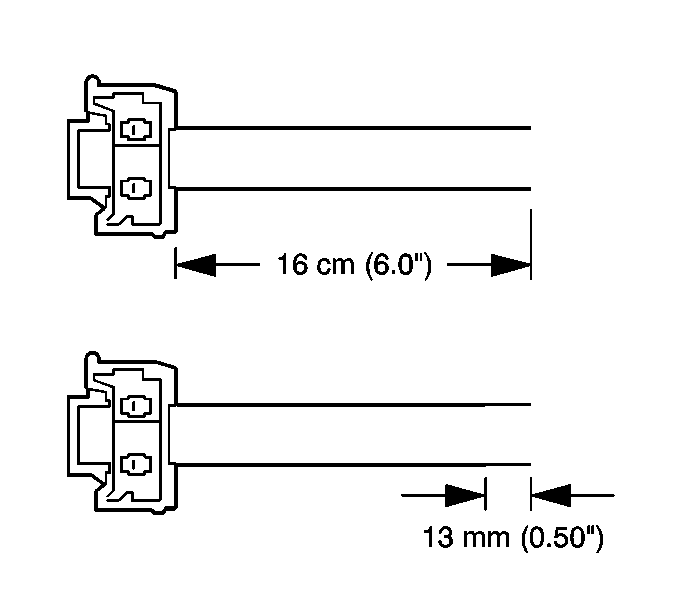
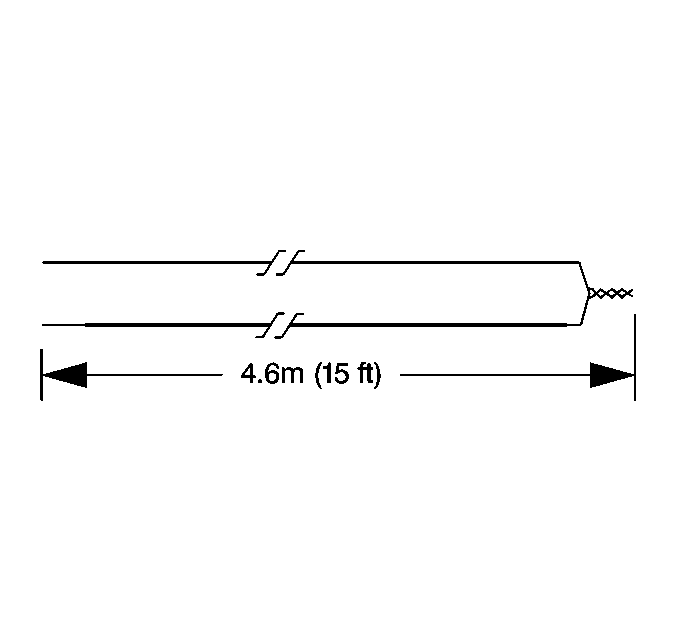
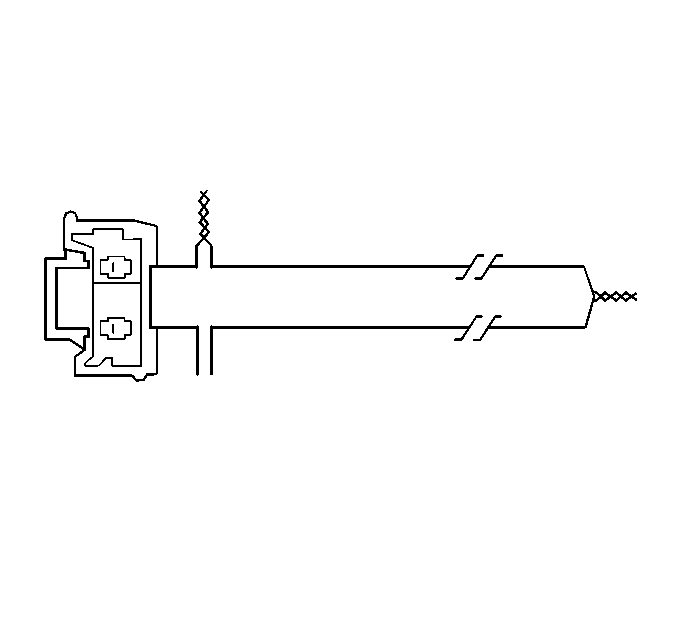
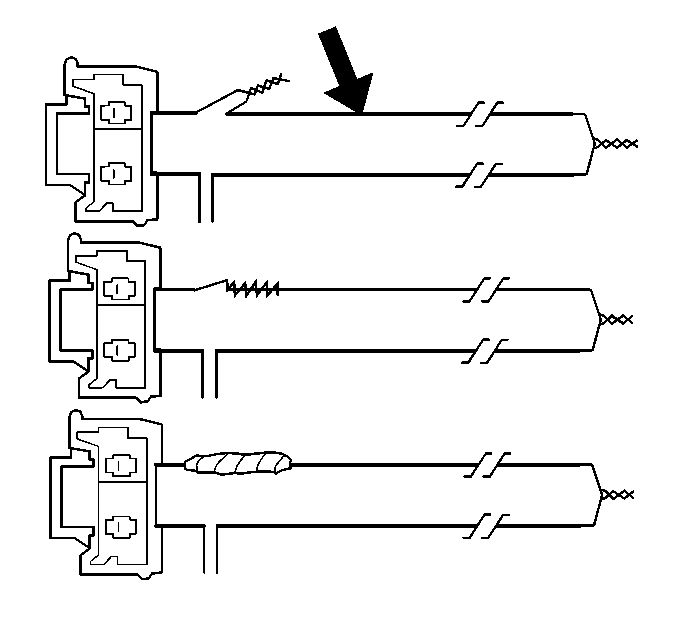
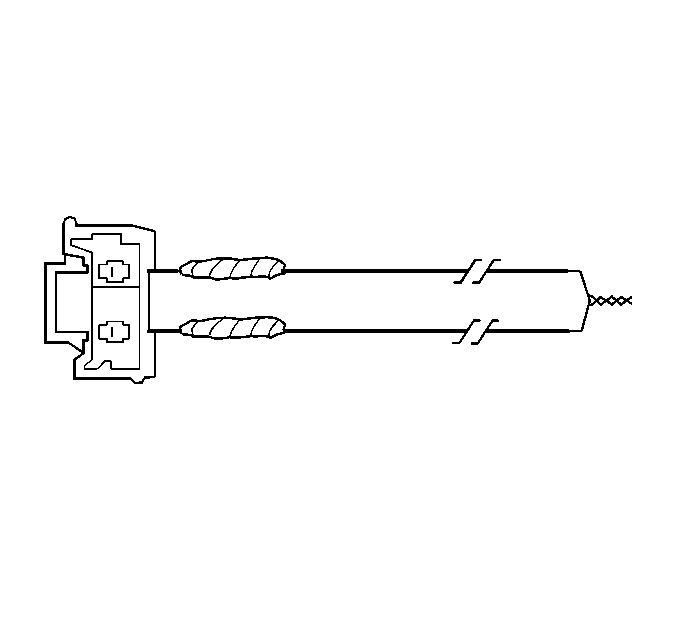
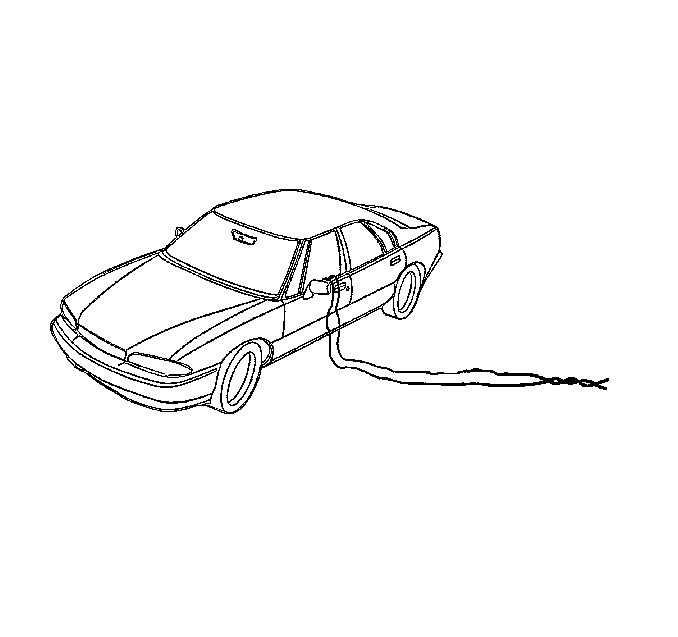
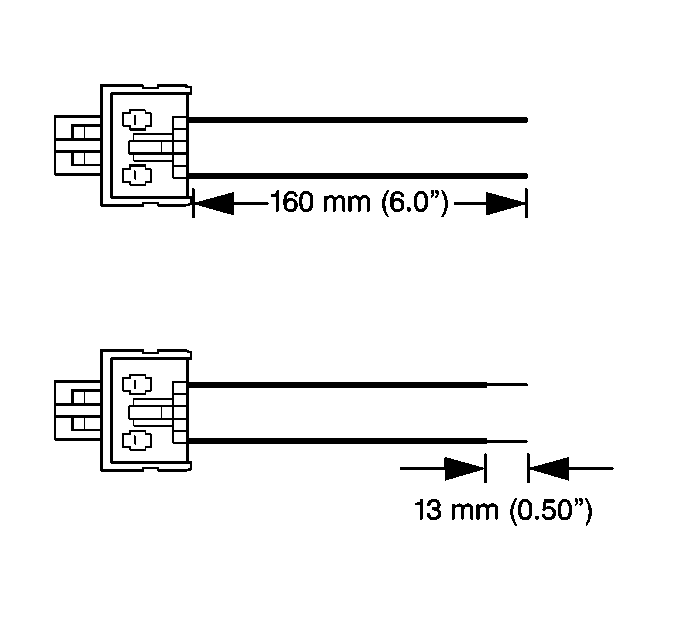
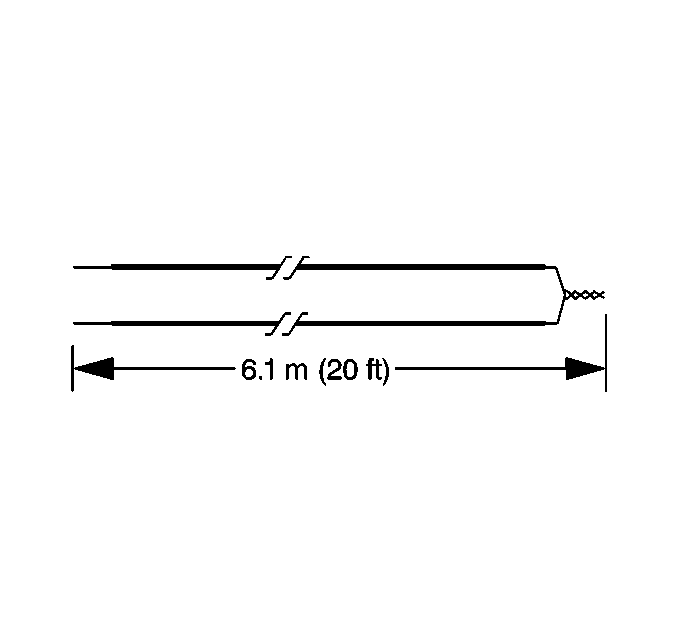
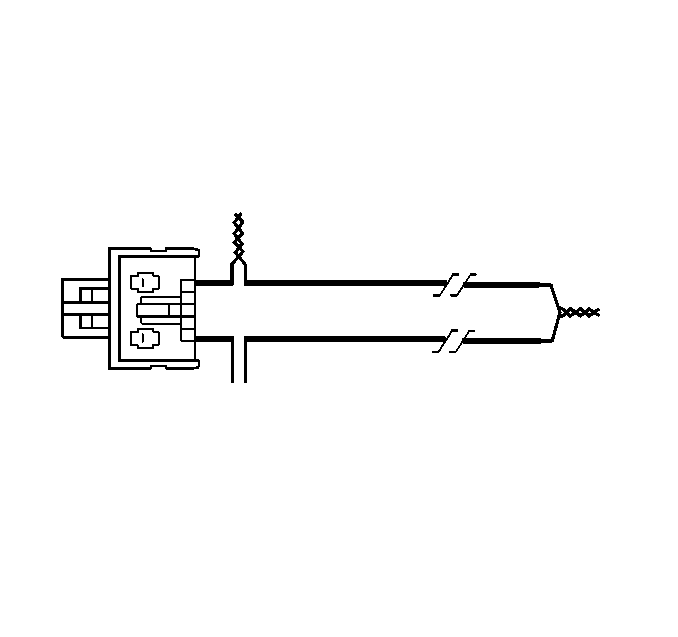
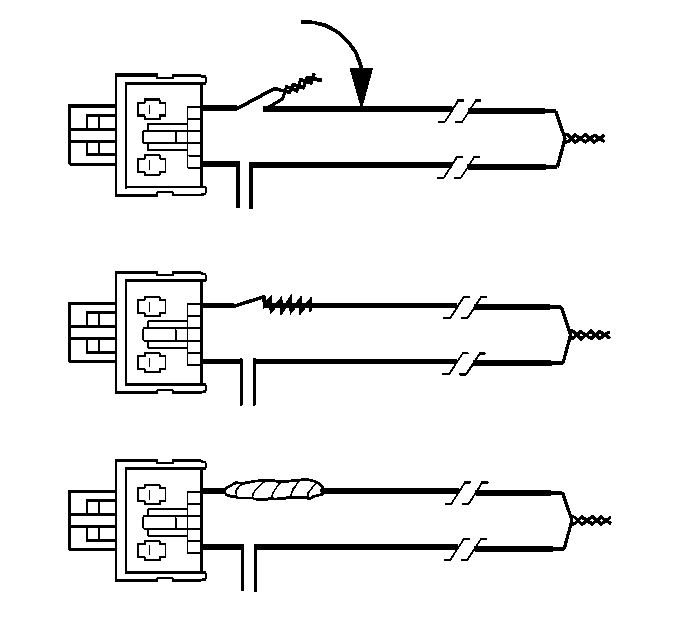
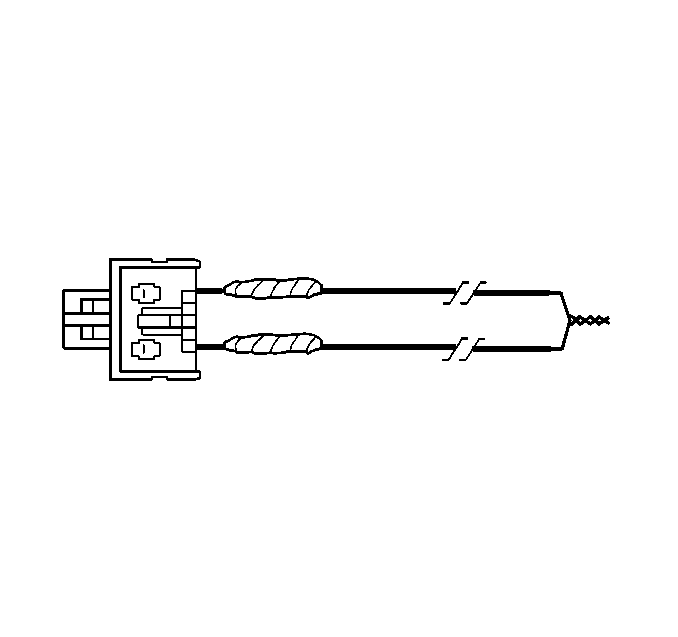
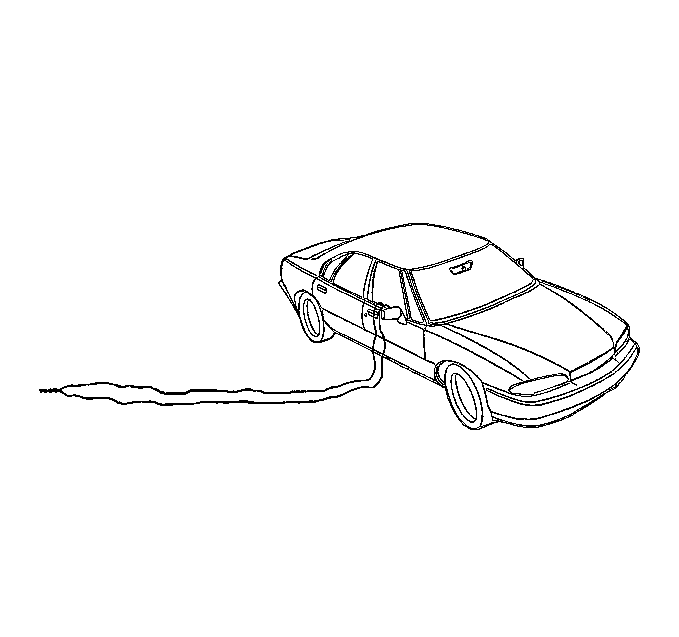

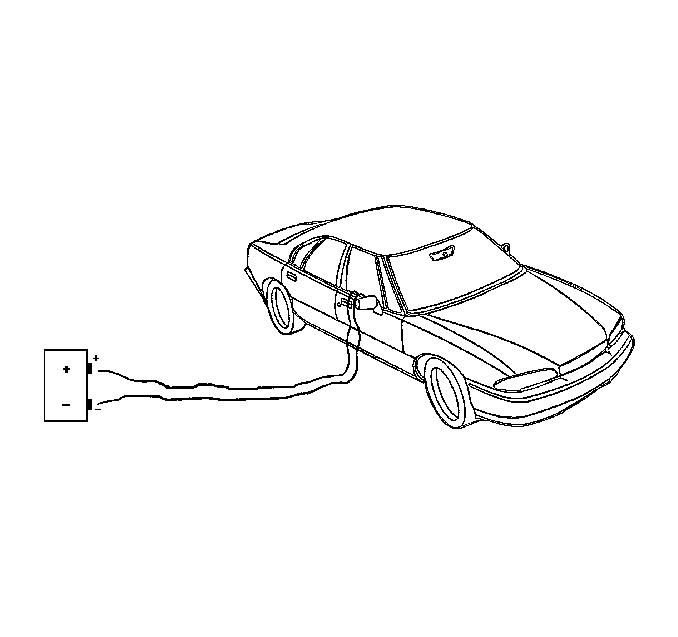


| 46.1. | Remove the undeployed module(s) from the vehicle. Refer to Steering Wheel and Column and Inflatable Restraint Instrument Panel Module Replacement . |
| 46.2. | Temporarily store the module(s). |
| 46.3. | Call the Technical Assistance Group for further assistance. |
Handling a Deployed Inflator Module

After the inflator module has deployed, the surface of the air bag may contain a powdery residue. this powder consists primarily of cornstarch (used to lubricate the bag as it inflates), and by-products of the chemical reaction. The deployment reaction produces sodium hydroxide dust (similar to lye soap). The sodium hydroxide quickly reacts with the atmospheric moisture. This atmospheric moisture converts the sodium hydroxide into sodium carbonate and sodium bicarbonate (baking soda). Therefore, you will probably find no sodium hydroxide present after the deployment. Gloves and safety glasses are recommended. Gloves and safety glasses prevent possible irritation of the skin or eyes.
